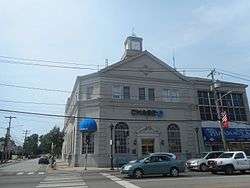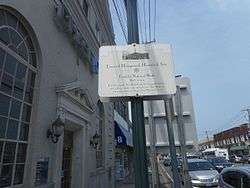Franklin National Bank
Franklin National Bank, based in Franklin Square in Long Island, New York was once the United States' 20th largest bank. On October 8, 1974, it collapsed in obscure circumstances, involving Michele Sindona, renowned Mafia-banker and member of the irregular freemasonic lodge, Propaganda Due. It was at the time the largest bank failure in the history of the country.
Franklin Square National Bank | |
 The original headquarters for Franklin National Bank on NY 24 and James Street, now a Chase Bank branch. | |
  | |
| Location | 952 Hempstead Turnpike, Franklin Square, New York |
|---|---|
| Coordinates | 40°42′27″N 73°40′39″W |
| Area | 0.35 acres (0.14 ha) |
| Built | c. 1929-1955 |
| Built by | Arthur T. Roth |
| Architectural style | Colonial Revival |
| NRHP reference No. | 15000776[1] |
| Added to NRHP | November 10, 2015 |
History and banking innovations
The bank was founded as Franklin Square National Bank in 1926 (but changed its name to Franklin National Bank in 1947). Its original location was built in 1929 on Franklin Square. It was subsequently expanded in stages through 1955. It consists of the original 1929 one-story, Colonial Revival style building; a 1939 expansion; a 1946/47 expansion which included the addition of a second floor, pediment, partial hipped roof, cupola, rear four-story addition and a two-story banking hall; and a 1955 four-story rear office addition and drive-through teller. The building remained the bank's headquarters until 1960, when a new headquarters was built in Mineola, New York.[2] The building was listed on the National Register of Historic Places in 2015.[1]

Arthur T. Roth joined the bank in 1934 as head teller and became president in 1946. Under his leadership, Franklin National Bank introduced many banking innovations, such as:
- Junior savings accounts (1947)
- The drive up teller window (1950)
- The bank credit card (1951)
- A no-smoking policy on banking floors (1958)
- Installed outdoor teller machines at branch banks (1968)
- Franklin Savings Bond which later developed into the Certificate of Deposit (1969)
In 1964, Franklin opened branch offices in New York City, and in 1967 merged with Federation Bank & Trust Company. In 1968, Roth was removed as CEO by his protégé, Harold Gleason, after an alleged conflict of interest real estate scandal involving Donald Roth and the proposed airfield development at Calverton, NY (see Newsday). In 1970, Roth lost his position as Chairman and was pushed off the board of directors in favor of an influential future promised by Michele Sindona. Gleason then became Chairman and Chief Executive Officer, inviting Laurence Tisch to join as Vice Chairman as he was a 22% shareholder.
Collapse
In 1972, Michele Sindona, a banker with close ties to the Mafia, the pseudo-masonic lodge P2, and the Nixon administration, purchased controlling interest in Long Island's Franklin National Bank, from Laurence Tisch, Chairman of Loews Corporation, which owned hotels in Italy. Later the U.S. Comptroller of the Currency declared Tisch an unqualified director for reasons of conflict of interest, paving the way for Sindona to take over Franklin. Sindona paid more than Tisch had paid for the stock. Tisch was later sued by the Federal Deposit Insurance Corporation (FDIC) for breach of fiduciary duty with respect to the sale of his shares to Sindona. Tisch had bought the shares in a gradual accumulation as a favor for Sindona. It would appear the sudden need to sell the shares and Sindona sitting in the wings, allowed the purchase of shares by Sindona to appear as a golden angel to the rescue. Harold Gleason orchestrated the situation by appointing Tisch as a Board Member, creating the conflict of interest circumstance which would allow Tisch to make the sale to Sindona for other than investment quality reasons. Neither the Comptroller of the Currency, the FDIC, or the Security and Exchange Commission showed any interest in the matter.
As a result of his acquisition of a controlling stake in Franklin, Sindona finally had a money laundering operation to aid his ties to Vatican Bank and the Sicilian drug cartel. Sindona used the bank's ability to transfer funds, produce letters of credit, and trade in foreign currencies to begin building a banking empire in the U.S. Allegedly Sindona used his influence in the Republican Party and the Nixon administration to ensure that his background did not inhibit his ability to become Vice Chairman and largest stockholder in the bank. Unfortunately Sindona began to suffer huge losses in the foreign exchange markets, and decided to defraud the bank of $30,000,000 to cover his losses, which brought the bank below its capital needs to operate. In mid-1974, management revealed huge losses and depositors started taking out large withdrawals, causing the bank to have to borrow over $1 billion from the Federal Reserve Bank.[3] On 8 October 1974, the bank was declared insolvent due to mismanagement and fraud, involving losses in foreign currency speculation and poor loan policies.[4]
In 1975, Peter Shaddick, the former executive vice-chairman of the bank's international division, pleaded guilty to fraud. Following their 1979 trial in Federal District Court in New York, Gleason, Paul Luftig, the bank's former president and chief administrative officer, and J. Michael Carter, a former senior vice president, were convicted of falsifying financial records. The Italian lawyer and liquidator of Sindona's Italian financial empire, Giorgio Ambrosoli, provided the US Justice Department with evidence to convict Sindona for his role in the collapse of the Bank.[5] Ambrosoli was killed by a Mafia hitman commissioned by Sindona in July 1979.[6]
In 1980, "mysterious Michele" was convicted in the United States and in 1984 was extradited to Italy.[7][8] In March 1986, he died of cyanide poisoning while serving a life sentence. Some sources indicate he was murdered, while others indicate he committed suicide. Murder could have been by actors in revenge of Sindona's alleged murder of the Pope. Others say there was fear that old men in jail talk as they contemplate their doom. Franklin's assets were later purchased by European American Bank, itself later acquired by Citigroup.
References
- "National Register of Historic Places Listings". Weekly List of Actions Taken on Properties: 12/07/15 through 12/11/15. National Park Service. 2015-12-18.
- "Cultural Resource Information System (CRIS)". New York State Office of Parks, Recreation and Historic Preservation. Archived from the original (Searchable database) on 2015-07-01. Retrieved 2016-02-01. Note: This includes Paul Van Wie and Jennifer Betsworth (July 2015). "National Register of Historic Places Registration Form: Franklin Square National Bank" (PDF). Retrieved 2016-02-01. and Accompanying photographs
- Time Magazine October 21, 1974 http://www.time.com/time/magazine/article/0,9171,944999,00.html
- Account Settled, Time Magazine, April 7, 1980
- "Justifiable Homicide", by Luigi DiFonzo, New York Magazine, April 11, 1983
- Andreotti says Ambrosoli 'Asking for it', ANSA, September 9, 2010
- Who killed Calvi?, The Observer, December 7, 2003
- (in Spanish) El poder en el mundo después de la "tangente", Clarín, May 23, 1996
St. Peter's Banker: Michele Sindona by Luigi DiFonzo; Franklin Watts 1983 ISBN 0-531-09889-3
External links
- Breaking the Bank Roth Built by George DeWan, Newsday Long Island History Site (archived Dec. 15, 2007)


